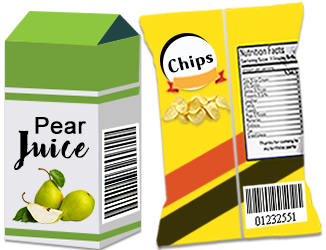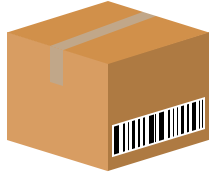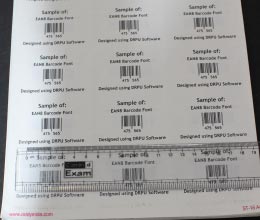How to Position your Barcode on the Product
Placement of your barcode on a package can affect how well scanners read it. In general, for items that are scanned at the checkout, you would place the barcode in the lower right corner of the back of the package. To help ensure a clean scan, we always advise staying away from edge of packaging and leaving enough space around the barcode.
Make sure the barcode is positioned on a flat surface without touching the edge or crease of the packaging in any way. The barcode should not have any corner wrapping. Staples shouldn't be able to read the barcode. On paper with perforations, seams, folds, or absorbency, do not print.
Barcode Placement for Consumer Packages

- There can be only one barcode per package.
- The bottom of the package should not have a barcode.
- Put the barcode low and preferably to the right on the back of the package.
- If at all possible, position the barcode between 8 and 100 millimeters from edge of the package.
Instructions for Special Consumer Packages
- Cans and Jar Items: Cans and other cylindrical objects with a diameter of under 12 cm. It is advised to position the barcode so that it looks more like a ladder than a fence.
- Composite Item: Barcodes of the products packed inside of a package should not be readable when the package contains multiple consumer goods. Hide the barcodes by packing the included items or the packaging so that the barcodes are facing inward and hidden.
- Bags and other Soft Packaging: Barcode should be put in the middle of the bag, where there is the least chance of wrinkles.
- Bottle: Either the main label or a separate label on the back should have a barcode. Never around the bottleneck on a banner.
Barcode Placement for Outer Packages

- Barcode must be printed on at least one side of the outer package.
- The bottom of the package cannot contain the barcode.
- Two sides should be marked if the package can't be turned while on a pallet.
- If a package in the grocery industry has a barcode on only one side, the pallet must be stacked with the packages so that one of the pallet labels is on the same side.
- Barcode on an outer package must be marked to be readable even when the package is on a pallet.
Barcode Placement for Pallets
In the manufacturing industry, pallets must have labels on two adjacent sides: the long side to the right of the short side and the short side itself. No regulation specifies whether the labels should be positioned to the left, in the middle, or to the right on these sides.
- At least 50 mm should separate the label from the edge.
- The outer packaging marking from under the label must be visible.
- Barcodes must be at least 400 millimeters and not more than 800 millimeters from the bottom of the label.
- Before stacking stretch-wrapped pallets to create a transport-optimized pallet, place the label on the outside of the stretch wrap for one-item pallets and layer stretch-wrapped pallets.
- If the layer pallets are not stretch-wrapped individually, the labels should be attached directly to the layer pallet or, if several layer pallets are plasticized together, placed in a plastic sleeve on top of the pallet.
- If there is a lack of space on, for example, layer pallets, the labels can be divided so that they are landscaped with the text on the left and the barcodes to the right. Remember that text and barcodes on labels should be the same size and quality as other labels.
Size and Shape Options for Barcode Labels
Size of Barcode Labels:The size and shape of the barcode label typically depend on the amount of data that needs to be encoded and the available space on the product or packaging.
- 1 inch x 1 inch
- 1.5 inches x 1.5 inches
- 2 inches x 1 inch
- 2.5 inches x 1 inch
- 3 inches x 2 inches
- 4 inches x 2 inches

In addition to these standard sizes, custom sizes can also be created to fit specific product dimensions or packaging requirements.
The shape of the barcode label is also a consideration when choosing the appropriate label for a particular application. Square or rectangular labels are common and provide ample space for the barcode and any associated information, while circular labels may be useful for products with curved surfaces. The shape of the barcode label should be chosen to ensure that the barcode can be read accurately by the barcode scanner.
Overall, the size and shape of barcode labels should be chosen based on the specific requirements of the application, with consideration given to the amount of data to be encoded, available space on the product or packaging, and the shape of the product or packaging.
Common Size and Adhesive Barcode Label Includes:
Barcode labels come in a variety of sizes and adhesive options to meet different requirements of various applications. Some of the most common size and adhesive options for barcode labels include:
-
Size:
Barcode labels can be as small as 0.25 inches by 0.25 inches and as large as 8.5 inches by 11 inches. The size of the barcode label usually depends on the amount of data that needs to be encoded and the available space on the product or packaging.
-
Adhesive:
The adhesive on the barcode label is important to ensure that the label stays in place and is not easily removed. Different adhesives are available for different surfaces, such as permanent adhesive for smooth surfaces or removable adhesive for delicate surfaces. Some barcode label adhesives are designed to withstand extreme temperatures, moisture, or chemicals.
-
Material:
Barcode labels can be made from various materials, such as paper, synthetic materials, or metallic materials. Paper labels are the most common and are suitable for most applications, while synthetic labels are more durable and resistant to moisture, chemicals, and tearing. Metallic labels are commonly used in industrial and manufacturing environments where the label needs to withstand harsh environments.
-
Color:
Barcode labels can be printed in different colors to make them more visible or to differentiate between different products or shipments. However, it is important to ensure that the barcode itself is always printed in black or a dark color to ensure accurate scanning.
-
Format:
Barcode labels can be printed in various formats, such as rolls or sheets, to fit the requirements of the application. Rolls are ideal for high-volume applications, while sheets are suitable for low-volume applications.
-
Size:
Barcode labels can be as small as 0.25 inches by 0.25 inches and as large as 8.5 inches by 11 inches. The size of the barcode label usually depends on the amount of data that needs to be encoded and the available space on the product or packaging.
-
Adhesive:
The adhesive on the barcode label is important to ensure that the label stays in place and is not easily removed. Different adhesives are available for different surfaces, such as permanent adhesive for smooth surfaces or removable adhesive for delicate surfaces. Some barcode label adhesives are designed to withstand extreme temperatures, moisture, or chemicals.
-
Material:
Barcode labels can be made from various materials, such as paper, synthetic materials, or metallic materials. Paper labels are the most common and are suitable for most applications, while synthetic labels are more durable and resistant to moisture, chemicals, and tearing. Metallic labels are commonly used in industrial and manufacturing environments where the label needs to withstand harsh environments.
-
Color:
Barcode labels can be printed in different colors to make them more visible or to differentiate between different products or shipments. However, it is important to ensure that the barcode itself is always printed in black or a dark color to ensure accurate scanning.
-
Format:
Barcode labels can be printed in various formats, such as rolls or sheets, to fit the requirements of the application. Rolls are ideal for high-volume applications, while sheets are suitable for low-volume applications.
Overall, the size and adhesive options for barcode labels should be chosen based on the specific requirements of the application, with consideration given to the material, color, and format of the label.